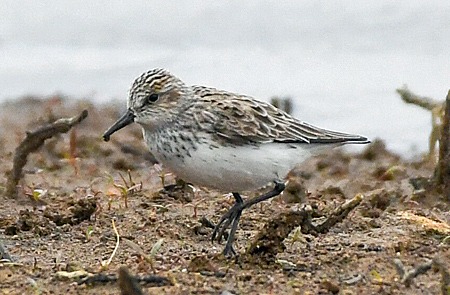Fully-palmated Birders Record 11 Locations, 17 Miles and 126 Species

Photo by Michael Sciortino
The Fully-palmated Birders (FPB for short) reconvened for the 2023 edition of the Loudoun Wildlife Conservatory’s Birdathon on Saturday and Sunday, May 6 and 7 with last year’s team largely intact. Michael Myers, Michael Sciortino and Mike Scott, were joined by John Denice, a newcomer to the team, to round out the group. Overall FPB recorded 126 species after visiting 11 different locations throughout Loudoun County. As is typical with our team, we covered some serious ground as we hiked over 17 miles in search of birds over the two-day period. While last year was defined by the number of waterfowl we recorded, this year was defined by the greater number of warblers. Waiting a few weeks certainly made a difference for us.
The team started at 5:45 am at the Algonkian Regional Park boat ramp as our first location of the day. This provided us a nice jump start to our Birdathon checklist with 78 species recorded in this location. In hindsight we should have started earlier as the team missed the Great Horned Owl that was calling earlier in the morning. We never did see or hear this species so that was a missed opportunity for us (perhaps next year). We were happy with the overall totals and especially happy with the number of warblers that were present. A few highlights were a lone Veery that was seen by all members of the team, and two Northern Waterthrushes were seen and heard. We were able to record a Black-and-white Warbler, Common Yellowthroat, numerous Northern Parulas, a Bay-breasted Warbler, both Black-throated Blue and Green Warblers, Palm Warblers, and the ever-present Yellow-rumped Warblers. Baltimore and Orchard Orioles were vocal along the trail, and we were treated to great looks of our first-of-season (for some) Ruby-throated Hummingbird in the honeysuckle shrubs to the right of the driving range. Red-eyed Vireos were plentiful, and we would go on to rack up observations at just about all other locations. White-eyed Vireos proved to be elusive and a bit worrisome as the day progressed; where were they? We spent some time at the mouth of Sugarland Run where a Rusty Blackbird posed for photos in the early morning sunlight.

Common Gallinule.
Photo by Michael Myers
The team moved to the Waterpark area and picked up our first American Redstart of the day. We would go on to hear and see more throughout our travels, but it was good to pick up this new species. We also recorded our first Barred Owl, Eastern Wood-Pewee and Yellow-throated Vireo of the event. We also saw our first Magnolia Warbler and would see one again at the Blue Ridge Center on Sunday. The waterpark area provided us with our only sightings of a Canada and Nashville Warbler of the outing. The species count was piling up nicely as we made it through midday on Saturday, but still no White-eyed Vireo.
Our next stop was Bles Park where we surely would be able to pick up some recently-recorded rare species. We recorded 43 species in total with the highlight being the Common Gallinule that was out in the open and in the sunlight for excellent photo opportunities. We tried in vain to get a look at the American Bittern, but we did get a glimpse and photograph of the Least Bittern hiding in the reeds where others have seen it in the past days. We counted a family of eight Wood Ducks on the pond, but there were no other duck species to be found. We also observed our first Brown Thrasher, Black Vulture, Solitary Sandpiper and Prairie Warbler of the day.

Spotted Sandpiper.
Photo by Michael Sciortino
Next up was Broad Run Stream Park at the junction of the Loudoun County Parkway and Evergreen Mills Road in the Dulles South area. This location has become quite the birding hotspot along Broad Run and is ranked number 16 in the number of species recorded in Loudoun County. We traveled the entire outer edge of the park and recorded 64 species over a two-hour period that covered 2.5 miles. Michael Sciortino and John Denice scoped out the park the weekend before as part of a special Loudoun Wildlife Celebrate Birds event, so we knew where to look. We were able to pick up nine new species at Broad Run, and the highlight was the Blue Grosbeak in its usual location on the trail paralleling Broad Run. We picked up our only weekend sightings of a Hermit Thrush, Red-tailed Hawk, Wilson’s Snipe and a flock of feral Rock Pigeons (they count). Grasshopper Sparrows were in their usual location along the banks of the collection pond, and we recorded our first Savannah Sparrow of the weekend.
The hero of the day at Broad Run was Mike Scott who rescued a turtle that was trapped in the mesh-covered jetty in the pond. As we passed by, we noticed a turtle flailing to escape its entrapment. We could not let the creature suffer. Mike precariously balanced himself and made his way to the end of the jetty to free the turtle. It would not have survived for much longer as it baked in the afternoon sun. We all agreed that something must be done with that mesh as it is a definite hazard to the turtles that live in the pond.
The final location for Saturday was at Middlesex Drive Pond on the eastern border of Loudoun County with Fairfax County. The resident Mute Swan greeted us as we eventually recorded 16 species. We were able to observe a Lesser Yellowlegs and an American Pipit that were on the island. Middlesex was the only location where we observed these species. Middlesex also gave us our first looks at five Blue-winged Teal, our surprisingly first Eastern Towhee and good looks at two Least Sandpipers. That capped a long day that got us well over 100 species with the Blue Ridge Center coming up first thing in the morning.

Wild Turkey.
Photo by Michael Myers
As we did last year, we started Sunday at the Blue Ridge Center for Environmental Stewardship at 5:45 am. We had a feeling that this location was going to pay birding dividends, and it sure did as we recorded 69 species and 13 of those we only found at here. The 13 included the always-reliable Louisiana Waterthrush, a Kentucky Warbler, a Magnolia Warbler as well as our first Rose-breasted Grosbeak. We did record four Acadian Flycatchers on the Farmstead Loop, which was a first of season for many of the team. At Arnold Lane we saw a Hooded Warbler high atop the canopy. We heard Eastern Meadowlarks calling from the field as expected at this location. On the way back into the woods we heard our only Common Raven of the weekend. Thrushes were abundant as we recorded seven Wood Thrushes, more Veerys, and two Swainson’s Thrushes. To round out this location, we did finally pick up our first observation of a White-eyed Vireo and counted five altogether. The team spent over six hours at the Blue Ridge Center and covered close to six miles of trails.
We decided to make a quick strike at trying to find Bobolinks. We had success last year at Clover Hill Road on the outskirts of Waterford in the pouring rain. This location is reliable, and we observed numerous Bobolinks in the field along with Eastern Meadowlarks and Red-winged Blackbirds. We made our way back to the Leesburg area with a quick stop at Meadowbrook Farm Ponds, and although we recorded 23 species we gained nothing that we did not already have. Michael Myers did get a nice photo of a family of Blue-winged Teal though. We were hoping that the Ruddy Ducks would be on the pond, but they were nowhere to be found.
As a new location for this year’s Birdathon, the team decided to visit Bazil Newman Riverfront Park to see if there were any waterfowl on the Potomac or Goose Creek or at the confluence of the two. Our overall observations were light on waterfowl, but it was worth a shot. Despite recording 34 species, hiking 3.2 miles, and spending close to two hours at this location, we recorded no new species. It was still a good experience as half of the team had not visited this park before. We did suddenly realize that we were missing a Ring-billed Gull, which is a usual sight along the Potomac. We could not finish our day without finding one.

Semipalmated Sandpiper.
Photo by Michael Myers
The team’s final stop of the weekend was on the west side of Beaverdam Reservoir for just one final species: the Ring-billed Gull. We spent all of 15 minutes at the reservoir as the rain began to move in. The reservoir was quiet with the water level extremely low due to the ongoing construction. There was nothing of note until we finally spotted two gulls almost on either end of the reservoir. As we were celebrating our achievement with high fives, we spotted a bonus Semipalmated Sandpiper on the near shore searching for food in the exposed lakebed. So the Fully-palmated Birders found a semipalmated sandpiper as our last species of the event. It was a fitting end to a long weekend of birdwatching.
All the driving and hiking was well worth it. It was a pleasure to participate with the other awesome teams and to raise money and awareness for Loudoun Wildlife Conservancy during this worthwhile event.
The post Fully-palmated Birders Record 11 Locations, 17 Miles and 126 Species appeared first on Loudoun Wildlife Conservancy.
The post Fully-palmated Birders Record 11 Locations, 17 Miles and 126 Species appeared first on Loudoun Wildlife Conservancy.



